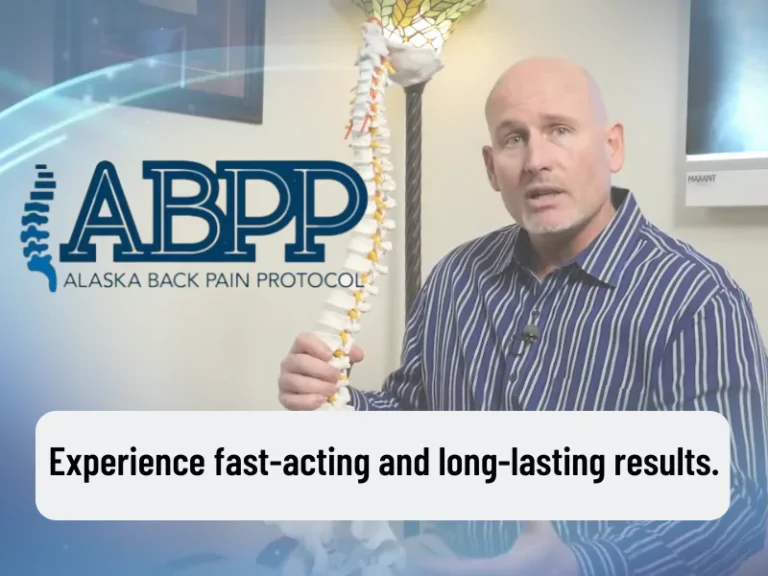Tendonitis, whether it is in your shoulder, knee, elbow, wrist, foot, or wherever it is, can be one of the peskiest and most annoying (not to mention painful) problems around.
While tendonitis can happen in any part of the body where a tendon has been overused, most people experience this injury near joints.
Tendonitis happens when the tendon and muscle have been overused beyond the body’s ability to repair and/or recover. Muscles have terrific blood supplies that bring healing nutrients and fresh oxygen, but our tendons (and other connective tissues) don’t!
This causes our tendons to become inflamed and unable to heal as quickly. Most people are unaware that they are developing tendonitis until it has become moderately painful.
How to treat tendonitis in the elbow, wrist, foot, or other joints? To prevent them from becoming a chronic problem, you should see your chiropractor as soon as possible.
How Long Does it Take for Tendonitis to Go Away?
That would depend on the overall health and age of the patient, as well as how severe a case of tendonitis is.
A mild case of tendonitis for a person under 40 could heal in two to four weeks. A moderate case in 4 to 6 weeks and an extreme case can take months.
It is important that you not ignore tendonitis, especially if it returns after you have tried the usual methods listed below.
Common Symptoms and Signs of Tendonitis
Mild cases of tendonitis can feel like a sore muscle, however, moderate tendonitis symptoms, depending on the affected area, can include:
- In the Elbow: Pain, sometimes quite sharp, on the outside of the elbow joint, with sore muscles or muscles that are painful to the touch, in the forearm and wrist. It can occur in the inner elbow, but this is not as common.
- In the Wrist: Pain is usually in the inner joint of the wrist or below the base of the thumb. The joint is tender and sensitive to the touch.
- In the Foot: Pain is felt in the Achilles heel and the foot is tender or sensitive when walking.
- In the Shoulder: When reaching up or lifting the arm, pain is felt in the shoulder.
- In the Knee: Swelling and stiffness are common, along with pain when bending, walking, or sometimes putting weight on the affected knee.
Tendonitis can make driving a painful task.
Can’t Tendonitis Be Left Untreated Until It Goes Away?
It can, but you should never ignore pain signals. Pain is your body’s way of telling you something is wrong.
Why should you never ignore tendonitis? Here are the top 5 reasons.

Reason #1 – It Rarely Gets Better
The first thing a doctor will tell you is that you need to “rest” the painful area. Unfortunately, rest usually works only with the mildest forms of tendonitis. As we mentioned earlier, most people are unaware that they have a problem until it reaches the moderate stage.
While resting your arm or foot will help, even if the tendon has moderate amounts of damage, it probably won’t take care of the inflammation.
You will also need to do some sort of stretching/strengthening/rehabilitation to the area, otherwise, when you return to your normal activities (including the one that caused this injury to begin with) you are only going to overuse that tendon again.
Imagine hitting your hand with a hammer over and over. Yes, putting down that hammer for a few weeks will help stop the pain, but when you return to hitting yourself with the hammer, do you think all that rest will make your hand stop hurting?
This is why most people who simply “rest” the affected don’t see improvement, at least, not for very long! It is best to see a chiropractor for tennis elbow or any other type of tendonitis.
Reason #2 – You Probably Won’t Leave It Alone

Will tendonitis heal on its own? It can, but for the reasons listed here, it rarely does.
Read again how long it takes for tendonitis to go away. If you need to completely rest your arm, hand, shoulder, or foot, do you think you can stop using it for 4-6 weeks?
To be honest, most people can’t do this. You probably have a job, children, or other responsibilities that don’t allow you the luxury of a beach vacation for 4-6 weeks.
Most people might take a week off, but even then, they rarely stop using the affected joint entirely. Once they return to their normal routine, the activity they are doing that has caused the tendonitis is resumed, and therefore, tendonitis also returns within days or a few weeks.
Reason #3 – It Can Become Chronic
Due to reasons #1 and #2, it is not uncommon for tendonitis to become chronic. If you are able to give the affected tendon 4-6 weeks of complete rest, you might have success but since most people cannot devote that amount to not using the joint, they re-injure themselves.
When this happens, the ongoing inflammation causes the tendons to become chronic. Healing chronic tendonitis is a long and painful process that sometimes requires surgery. A chronic case of tendonitis will not only take months to heal, but you will also need rehabilitative therapy to strengthen the area.
Living with the pain of chronic tendonitis, no matter which joint is affected can become a nightmare. While mild cases might feel more like a sore muscle, chronic cases of tendonitis can feel like a knife is being driven into the joint, even with performing simple tasks such as pulling on a door handle.
Because chronic tendonitis takes so long to heal, some doctors opt for surgery, especially if other conservative methods are not effective or are only providing minimal relief.
Reason #4 – You Want to Avoid Surgery
 As we mentioned earlier, most people are not even aware that they are developing tendonitis until it has become moderately painful. Unless you have sustained an injury where the tendon has been cut or torn, you will most likely try the above methods with little success.
As we mentioned earlier, most people are not even aware that they are developing tendonitis until it has become moderately painful. Unless you have sustained an injury where the tendon has been cut or torn, you will most likely try the above methods with little success.
This continued use of the joint means inflammation will grow substantially. In severe cases of tendonitis, where more conservative treatments have not helped or, more likely, where no treatment was given at all, surgery will be required.
Unfortunately, when it comes to surgery on a tendon, it’s not as simple as healing a broken bone. In some cases, the joint becomes permanently stiff and a full range of motion might never return to the area.
Healing time after surgery is about 12 weeks but depending on the overall health and age of the patient, it can take as long as 6 months.
Almost everyone can avoid surgery, however, if you seek out proper treatment as soon as you feel joint pain or realize that you have tendonitis.
Reason #5 – Your Body Will Heal with Proper Treatment
How do you heal tendonitis fast? By getting treatment as quickly as possible! Even if it’s not tendonitis but a pulled shoulder muscle, for example, your body will heal faster when the proper treatment is applied.  Tendonitis responds very well to chiropractic care, including manipulation and ultrasound. Depending on your diagnosis, your chiropractor might also use other types of therapies as a part of your tendonitis treatment plan, including:
Tendonitis responds very well to chiropractic care, including manipulation and ultrasound. Depending on your diagnosis, your chiropractor might also use other types of therapies as a part of your tendonitis treatment plan, including:
- Chiropractic massage
- Heat therapy
- Supervised exercise and stretching programs
- Cold laser therapy
Your chiropractor will do a complete exam and will most likely order x-rays to determine if the pain you are experiencing is tendonitis or possibly some other type of joint problem.
Since chiropractors do more than treat the symptoms, they will look at your entire body and lifestyle to discover the root of the problem, thereby preventing tendonitis from reoccurring and allowing it to become chronic. 
The doctor might suggest ergonomic changes to your workstation, offer you advice regarding appropriate anti-inflammatory supplements to lower the inflammation levels surrounding the tendon, or refer you to a different specialist if you have other issues that fall outside their range of practice.
Chiropractors are highly skilled specialists in the musculoskeletal aspect of the body. They are your best option when it comes to healing tendonitis quickly.
What Happens if Tendonitis Goes Untreated?
Untreated tendonitis can lead to a permanent weakening of the tendon. This often results in a rupture of the tendon, which will require surgery to repair. It can also cause permanent damage to the affected tissues in the area.
Repeated bouts with tendonitis will result in scar tissue forming in the area. Pain and inflammation will continue to form since scar tissue is less flexible than tendons. This often causes people to “force” the affected joint to work harder, which causes more inflammation. To gain a better understanding, you can refer to this scientific study on Tendinosis.
Does Tendonitis Go Away and Come Back?
Yes, tendonitis can indeed recur after treatment. This is particularly common when the underlying causes, such as tendon overuse or systemic inflammation, are not adequately addressed. When the tendon has been inflamed once, it can become more susceptible to future inflammation, especially if it’s not given enough time to heal fully, or if the activities that led to the initial inflammation are resumed too quickly. Therefore, it’s critical to follow through with the complete course of treatment and make any necessary lifestyle adjustments to effectively manage and prevent recurrent bouts of tendonitis.
Time Off Work Due to Tendonitis: A Necessary Measure
Taking time off work is often a necessary step in the recovery process for individuals suffering from tendonitis. The duration of this period depends largely on the severity of the condition and the physical demands of the patient’s occupation. Rest is paramount in mitigating further inflammation and facilitating the healing of tendons. Patients should remain in close consultation with their healthcare provider to determine an appropriate timeline for returning to work. It’s important to bear in mind that a rushed return can exacerbate the condition and prolong the recovery period.
Can Tendonitis Get Worse with Rest?
While rest is typically beneficial in the recovery process for tendonitis, it’s important to note that in some cases, the condition may appear to worsen with rest. This is particularly true when the resting period is too prolonged, leading to joint stiffness and decreased tendon flexibility. Hence, the role of physical therapy and light exercises in tendonitis treatment can’t be overstated. They help maintain tendon mobility and strength during the healing period, ensuring a balanced approach to recovery. Always consult with a healthcare professional before starting any exercise regimen while recovering from tendonitis.
Why Am I Getting Tendonitis Everywhere?
Tendonitis developing in multiple locations may be indicative of a systemic issue or an underlying health condition. Chronic inflammation, often associated with autoimmune disorders, could make your tendons more susceptible to injury and inflammation, resulting in widespread tendonitis.
A second factor could be overuse or frequent engagement in high-demand physical activities without proper rest and recovery. Repetitive motions or sudden increases in the intensity of physical activities can put excess strain on your tendons, leading to tendonitis in various parts of the body.
Lastly, certain lifestyle factors such as poor diet, lack of exercise, obesity, and smoking can also contribute to the development of tendonitis in multiple areas. These factors can cause systemic inflammation, reduce blood flow, and slow down the healing process, leaving you more prone to injuries like tendonitis. It is crucial to address these root causes alongside seeking treatment for the symptoms to effectively manage and prevent tendonitis.
For more detailed information and scientific findings on the topic, you can refer to the following articles in reputed scientific and medical journals:
- Chronic Inflammation and Autoimmune Disorders contributing to Tendonitis
- Impact of High-Demand Physical Activities on Tendon Health
- Impact of Repetitive Motions on Tendon Health
- Role of Lifestyle Factors in Tendon Disorders
These articles provide evidence-based insights into the potential causes of widespread tendonitis and can serve as valuable resources for those looking for more in-depth understanding or exploring preventative measures.
Conclusion
Untreated tendonitis can become a life-long pain issue that interferes with even everyday tasks such as dressing, walking, eating, or brushing your hair. Don’t let this happen to you!
We encourage you to contact us for an appointment at Better Health Anchorage or Better Health Juneau.
Our friendly staff will be happy to check your insurance coverage and determine your deductible or copay. If you don’t have insurance, this doesn’t mean that you can’t afford the treatment you deserve. Read this article first!
Don’t suffer in pain! Get started down the road to recovery and get back to living a healthy, pain-free life!









